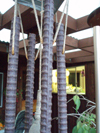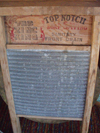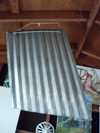Source Material - Percussion Instruments
My use of found percussion is varied and wide-ranging,
from solo playing to large ensemble work. This page discusses many of the different materials used, my influences
on modification and use, how I've used these materials, and (most importantly)
any general practicalities. |
| Found Metal - |
 |
Street Light Reflectors - Have a soft bell-like tone when struck on their edges. I've made several sets of instruments hanging on nylon cord.
|
 |
Mixing Bowls - Have a much louder, long ringing sound than the SLR when held upside down and struck at the edge. They also work well placed upside down and struck at the top, with a very high pitch attack. |
 |
Lobster Pots - Have a different timbre than the MB, with very different overtones due to their cylinder shape. Placed upside down they offer a longer ringing tone with more overtones than the MB.
|
 |
Fire Bells - I have a large collection of fire bells with semi-definite pitches. These work well struck on their edges for long ringing sounds or on their tops for a high-pitched shorter sound.
|
 |
Boat Bells - Due to their construction, boat bells have very interesting overtones, giving them a "broader" sound then many of the bells in my collection, with a full sound and a long ring. |
 |
Coffee Cans - CC have a slightly muffled, "gongy" ring when held from the bottom and struck near the top (see Roscoe Mitchell's recording Sound), and have a high pitched, sharp attack sound when turned upside down and struck with chopsticks or other mallets. |
 |
Cooking Pans - Are very trashy, and sound great bowed or struck, mounted or placed on other objects. |
 |
Tins - My mother had a large collection of tins in various sizes, and I've used some of them for playing on. They work well placed upside down and struck with chopsticks or other mallets. I've seen Brad Dutz and Curtis Glatter make great use of tins in their percussion setups. |
 |
Food Trays - Dave Golia gave me a few food trays in 1993, I used one in my percussion box for a while. Moe! Staiano (with Sleepytime Gorilla Museum) makes great use of food trays by mounting several of them on a large board. |
 |
Grates - My collection of grates range from a small heating grate roughly eight inches by six inches to several large metal grates that were used as foot rails on tractors. All have a wide variety of striking areas and sounds and work in a variety of situation, often amplified. |
 |
Springs - From the Brazilian Reco-Reco to the frames, springs have limitless possibilities depending on their size and shape. Often, attaching them to resonant bodies (drumheads, other metal objects) or amplifying them extends their possibilities.
|
 |
Rebar - Rebar has a long ringing tone similar to pipes when held at the nodal point and struck. I've made several wind chimes using rebar and other materials.
|
 |
Water Pressure Caps - WPC have a very short high pitch ring when struck with any hard mallet.
|
 |
Saw Blades - My interest in SB started with Emil Richards book "World Of Percussion". I have built various mounts for SB but after some time of research I stopped using these instruments. I think that the gimmick factor started to out-weight the sound possibilities. |
 |
Brake Drums - I got involved with BD after seeing pictures of Steel Band Orchestras in Trinidad and Tobago. Depending on the instrument, BDs give off an almost-definite pitch. Several different pitched BDs work well for melodic possibilities, and BDs are always useful for high-pitched accents. |
 |
Hubcaps - HC work great for alternative gongs. Often different models have extreme sound differences, when making sets I often use several from one car. It is very hard to find metal hubcaps these days. |
 |
Bicycle Wheels - Both the wheel and the spoxe of a BW work well, often I amplify the sounds, as seen on the frame 2. |
 |
Drum Parts - I've used drum rims, lugs and other junk parts for everything from shaker material (lugs and washers) to windchimes (rims). |
 |
Keys - Work well strung together in a wind chime fashion. |
 |
Pipe - Pipe work for a variety of possibilities, most often I use graduated lengths for instruments, either mounting them on a frame (like a marimba) or hanging them (like chimes). Copper seems to bend and disfigure easily, iron doesn't ring well, aluminum works well in most cases. I've had very good luck with fence post piping. |
 |
Washtubs - Thank you Lou Harrison. |
 |
Washboard - The washboard at left was given to me by Danlee Mitchell. Traditionally, the rub-board is played using thimbles on your fingertips. I have found useful sounds using metal or plastic or wood strikers/scrapers. The board is also easily placed on other drums for playing possibilities on a drumkit.
|
 |
Tinfoil - Recently I've been experimenting with tinfoil. The sound is very quiet but works well for many settings. Bowing the foil is wonderful, as is using it to prepare drumheads. |
 |
Scrap Metal - I have a very large collection of scrap metal picked up a scrap yards. Often I grind off sharp edges and sometimes drill holes for mounting. |
| Flat Metal (modified) - |
 |
Thundersheets - Thundersheets are large sheets of thin metal which are struck or shaken to sound like thunder. The thundersheets I've built are made of thin aluminum with sizes ranging from three feet by three feet to eight feet by four feet. Some sheets work well mounted, I've had good luck with one sheet in particular which is slightly thicker than usual for sounds somewhere between a thundersheet and a bell plate. |
|
Bell Plates - Bell Plates are smaller, thick pieces of metal giving semi-definite pitches when struck. I have made plates of various sizes and shapes, most of them generally square or rectangle. In general I've found that the thicker the metal the better the instrument seems to sound (it also makes it heavier to carry). My two main plates are ¼ inch thick steel measuring 7 ½"/13" and 7 ½"/10"; I also have several smaller, thinner steel plates and a large aluminum plate measuring 17"/20". All of these are drilled at their nodal points and mounted using nylon cord. |
| Odd Shaped Metal (modified) - |
 |
Air Duct - I found an old air duct from a building and have been using it for different sounds. It works especially well when spinning the duct as you play it.
|
 |
Trash Can Lids - Most of my trash can lids have been modified by grinding away the edges to form "cymbal-like" lids, or attaching handles in the middle of the lid to be played as hand cymbals.
|
 |
Fifty Gallon Oil Drums - Oil drums work well as large resonant instruments. I admit I have not investigated this to its fullest potential.
|
 |
Modified Cymbals - My interest in modifying cymbals was influenced by percussionists Steve Reid, David Moss and Gino Robair. These cymbals range from lathing broken cymbals down to small "bell" cymbals (as seen on the frame), to grinding the cymbals into spirals. Lately I've been cutting, drilling and bending cymbals into different shapes for different sounds. |
 |
Aluminum Siding - makes great trashy thundersheets if you can get it in large pieces.
|
 |
Square Steel/Aluminum Tubing - I have used this tubing cut to graduated sizes to get "anvil-like" sounds. |
| Pottery - |
 |
Flower Pots - My involvement with flower pots comes from Frederic Rzewski's piece To The Earth. Depending on the pot, FP can have a bell-like ringing tone or a dead clunk. I generally use chopsticks or soft yarn or cord mallets. |
| Ceramics - |
 |
Mixing Bowls - MB sound great when played with mallets or chopsticks, with a slightly muffled bell-tone. |
 |
Food Bowls - Seem to be the smaller, higher pitched equivalent to MB. |
 |
Tiles - I must admit that I haven't spent too much time investigating tiles. I have found that their short ringing tone can be helped by elevating their nodal points with cloth or tape. I have also worked with amplifying the sound with contact mic's which gives a few more options. Glenn Kotche makes great use of tiles in his percussion setups. |
| Plant Material - |
 |
Cactus - I began to experiment with amplifying cactus when working on John Cages piece Child Of Tree. I have found the most success with bulbous cacti with longer spines. Most of my cacti are small and in plastic pots, allowing for easy amplification by placing the mic on the pot instead of the plant. Generally I use toothpicks or chopsticks to play the spines. |
 |
Seed Pods - I have found several large seed pods that, when dried out, work well for gentle shaker sounds.
|
 |
Water Drums - I was inspired by Pierre Favre's work with water drums, which are large gourds filled with water and smaller gourds are placed upside down in the water. The bass response from these instruments is incredible. I'm still looking for the perfect mallet, but I generally use a large yarn mallet or large bass drum mallet to emphasize the lows. |
 |
Gourds - Gourds have a resonant sound and unique character when played with hands or mallets. They also work well when filled various objects.
|
 |
Rutes - Rutes are mallets made from binding several small twigs together to form a bundle-like stick. Great for slapping or whipping sounds. |
 |
Tree Branches - I've used tree branches various contexts. They work well shaken for a quiet, diffused sound or scraped against other objects. |
| Plastic - |
 |
Ridged Pipe - My first use of ridged pipe was when I was searching for a guiro substitute for Karlheinz Stockhausens piece Zyklus. Since that time I've use smaller pieces mounted in different ways. Pipe works well for scraping sounds and has a softer timbre and more diffused attack than wood. |
 |
Hose - My use of hose is mostly in building wind instruments. The main use has been to build dopplerophones with double-walled hose. Also, you can change the pitch of the drum by attaching a hose to a drums airhole and breath into it, which causes the heads to expand. |
 |
Airhoses (Whirly Tubes) - An airhose is a tube that, when spun in the air, emits several different tones, depending on the speed it is spun. Depending on the hose you can usually get three or four tones out. These tubes are ridged on the inside and are usually used for pool cleaning. It is very hard to find a good airhose. |
 |
Mylar - Mylar is usually used for drum heads, but I've found other uses for it such as using old heads placed on top of drums for muffling. Also you can modify the mylar heads by attaching string or springs, or you can cutting holes in the head and, by bowing it, create different sounds. |
 |
Plastic - Cut out of an old storage tub, I have cut several circular plastic pieces that fit onto drumheads for extreme muffling and a "tubby" sound. |
 |
Water Jugs - I have several large water jugs that have very deep bass tones when played on the bottom with mallets or hands. These work very well when amplified.
|
 |
Large Combs - I got several large combs from the county fair several years ago. The comb spines give very rapid glissandi when plucked, and they look great. |
 |
PVC - I have used PVC pipe for drum shells, and as an alternative cana brava (think ghetto rumba). |
